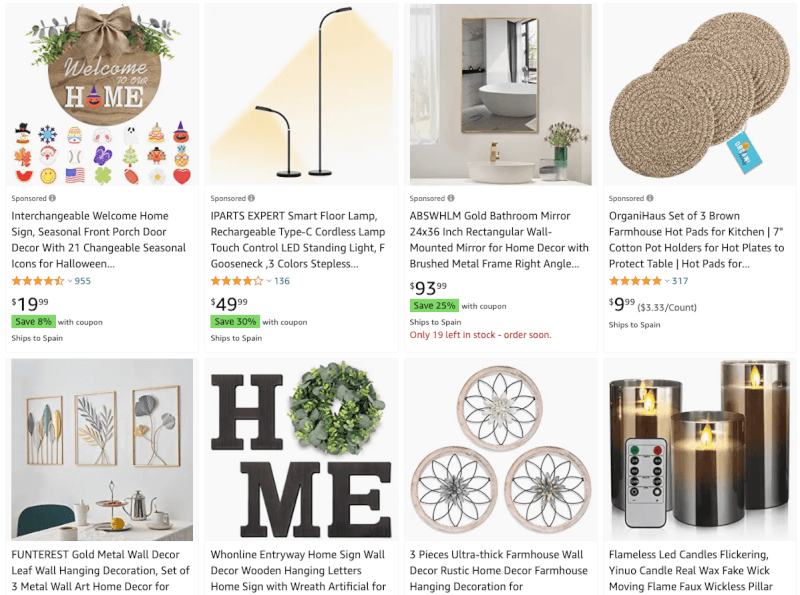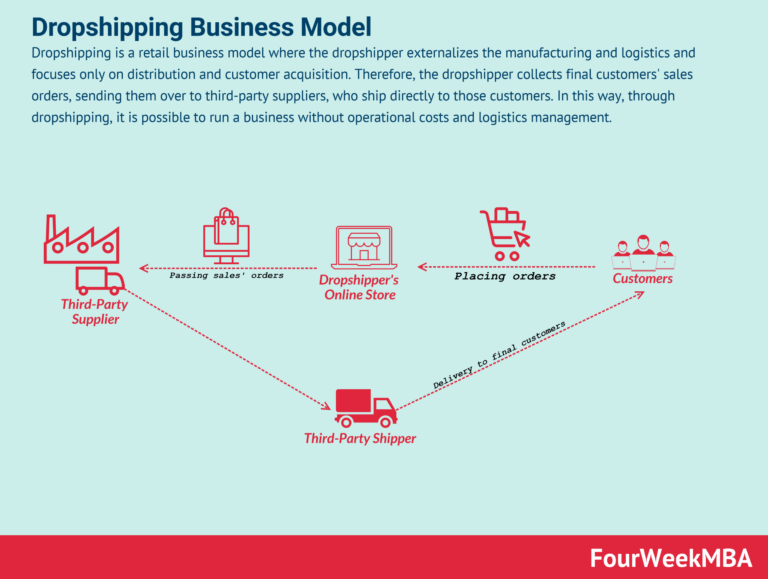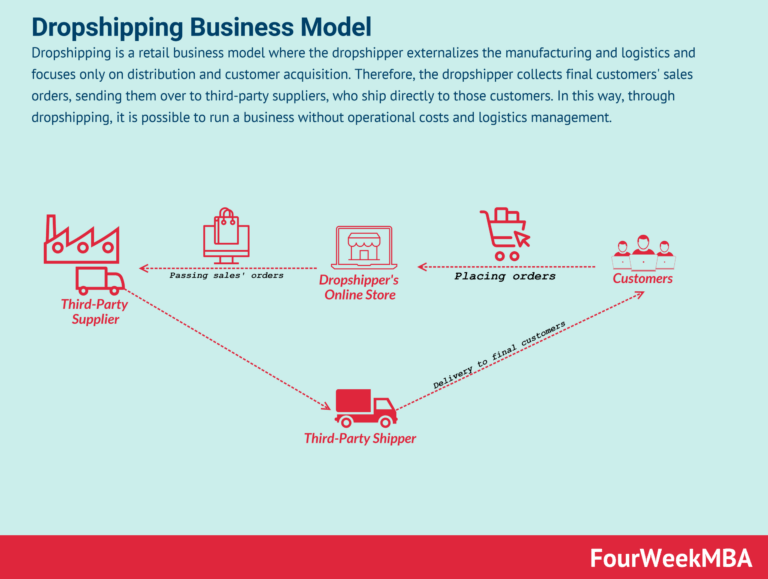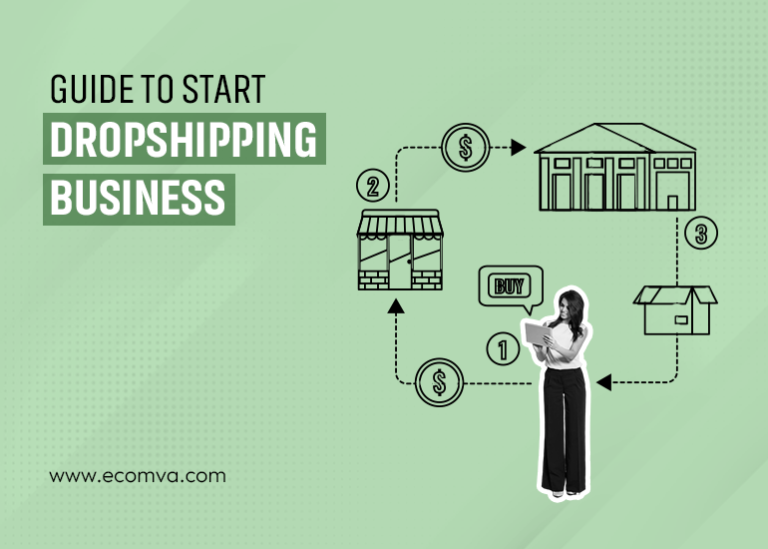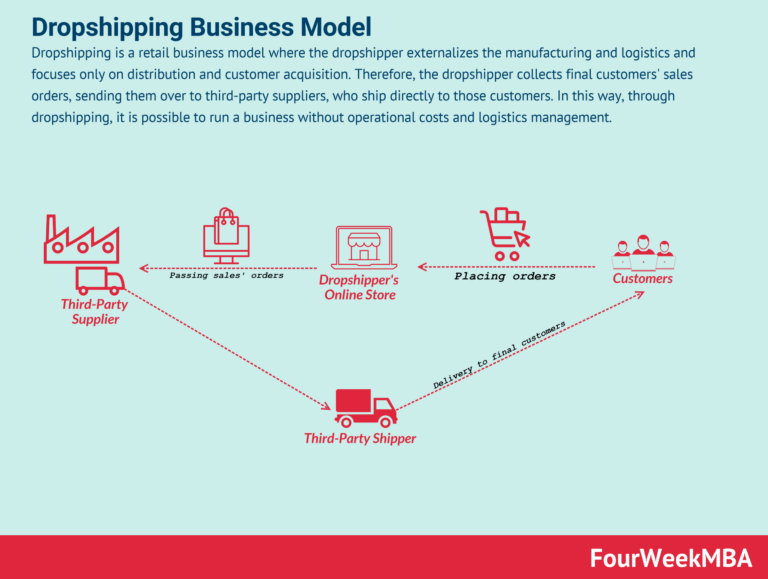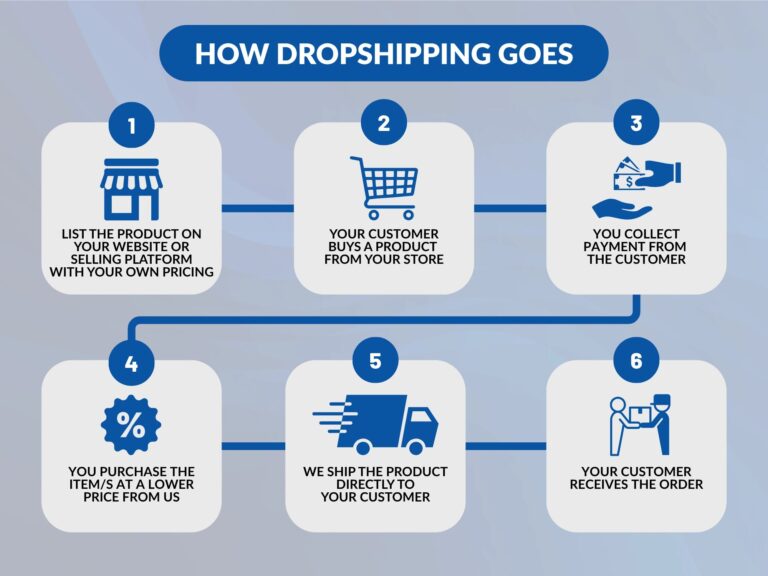How to Start Dropshipping in 2025 (A Beginner’s Guide)
Your Complete Guide to dropshipping home decor
Welcome to Your Entrepreneurial Journey
Congratulations on taking the first step towards launching your own business! The world of e-commerce is brimming with opportunities, and dropshipping is one of the most accessible paths for aspiring entrepreneurs like you. By focusing on home decor, you’re tapping into a thriving market that continues to grow as people seek to beautify their living spaces.
So, what exactly is dropshipping? In simple terms, dropshipping is a retail fulfillment method where you, the seller, don’t hold any inventory. Instead, when you sell a product, you purchase the item from a third party—usually a wholesaler or manufacturer—who then ships it directly to your customer. This means you can offer a wide range of products without the need for a large upfront investment in inventory or storage space, making it an ideal choice for beginners.
The appeal of dropshipping is clear: it requires minimal startup costs, offers flexibility in managing your business from anywhere, and allows you to focus on marketing and customer service rather than logistics. Imagine being able to curate a beautiful selection of home decor items—from elegant furniture to charming accessories—without the headache of inventory management. This model not only reduces risk but also gives you the freedom to pivot your product offerings as trends change.
In this comprehensive guide, we will provide you with a complete roadmap to success in dropshipping home decor. Here’s what you can expect:
- Finding Your Niche: We’ll explore how to identify profitable home decor products that resonate with your target audience.
- Setting Up Your Online Store: Learn the ins and outs of creating a visually appealing and user-friendly online store.
- Sourcing Reliable Suppliers: Discover how to partner with trustworthy suppliers who offer quality products and reliable shipping.
- Marketing Your Products: Gain insights into effective marketing strategies to attract customers and drive sales.
- Managing Orders and Customer Service: Understand the importance of excellent customer service and how to streamline your order management process.
By the end of this guide, you will be equipped with the knowledge and tools to turn your entrepreneurial dream into a reality. It’s time to embrace the exciting world of dropshipping and take charge of your financial future. With dedication and the right strategies, you can build a successful home decor business that not only reflects your style but also brings joy to countless customers. Let’s get started!
What You’ll Learn In This Guide
- Your Complete Guide to dropshipping home decor
- How Does Dropshipping Actually Work? A Step-by-Step Breakdown
- The Pros and Cons of Dropshipping: Is It Right for You?
- Step 1: Finding a Profitable Niche and Winning Products
- Step 2: Choosing the Right Dropshipping Suppliers
- Step 3: Building Your Online Store
- Step 4: Marketing Your Dropshipping Business to Get Sales
- Common Mistakes to Avoid as a Beginner
- Frequently Asked Questions (FAQs) about dropshipping home decor
- Conclusion: Your Next Steps to Launching Your Business
- Important Disclaimer
How Does Dropshipping Actually Work? A Step-by-Step Breakdown
Understanding the Dropshipping Model
Starting a dropshipping business can seem overwhelming, but breaking down the process into manageable steps makes it much simpler. Think of yourself as a digital storefront that connects customers with products without ever having to handle inventory directly. Here’s how the dropshipping model works, step by step:
- Customer Places an Order on Your Online Store
-
When a customer finds a product they like on your website and decides to purchase it, they add it to their cart and complete the checkout process. This is your first interaction in the dropshipping process. The customer is excited about their purchase, and you’re ready to deliver excellent service.
-
You Receive the Payment
-
After the customer completes their order, you receive the payment, which typically includes the product cost plus any shipping fees. This payment goes directly to your business account, minus any transaction fees charged by your payment processor (like PayPal or Stripe). At this point, you have the funds to fulfill the order.
-
You Forward the Order to Your Supplier
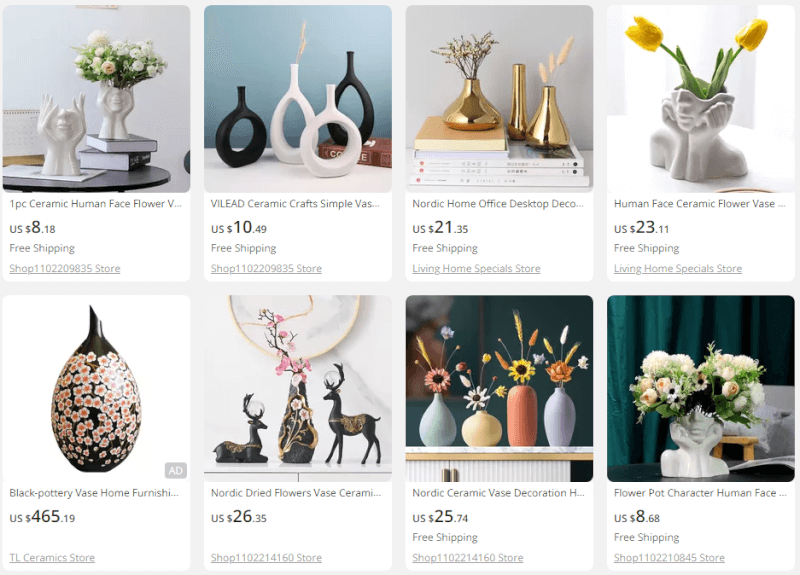
-
Next, you take the order details and forward them to your supplier. This can be done through an automated system if your supplier offers one, or you can manually enter the details into their system. This step is crucial because it triggers the fulfillment process. Make sure to double-check the order for accuracy to avoid any issues later on. You are essentially acting as the middleman, facilitating the transaction between the customer and the supplier.
-
The Supplier Ships the Product Directly to the Customer
- Once your supplier receives the order, they prepare and ship the product directly to your customer. This is where the magic of dropshipping happens. Your customer receives the product without ever knowing that it came directly from the supplier. You don’t handle the product at all, which saves you time and storage costs. The shipping label will typically have your business name, maintaining the appearance of a seamless transaction.
Flow of Money and Goods
To clarify the flow of money and goods in dropshipping:
- Money Flow:
- Customer → You (retailer) → Supplier
-
The customer pays you the retail price, and after you fulfill the order with your supplier, you pay them the wholesale price. The difference between these two amounts is your profit.
-
Goods Flow:
- Supplier → Customer
- The supplier directly ships the product to the customer, which means you never have to handle the inventory or deal with shipping logistics.
Analogy to Simplify the Concept
Imagine you are a restaurant owner who doesn’t cook the food but instead takes orders and communicates them to a nearby kitchen. When a customer orders a dish, you take their payment, send their order to the kitchen, and the kitchen prepares and delivers the meal straight to the customer. You are the face of the restaurant, but the actual cooking and delivery are handled by the kitchen. This is similar to how dropshipping works: you market and sell the products, while your supplier takes care of the rest.
Conclusion
Starting a dropshipping business can be an exciting venture with minimal upfront investment. By understanding the step-by-step process and the flow of money and goods, you’ll be better equipped to launch your home decor store successfully. Remember, every great business starts with a single step—so take that step today!
The Pros and Cons of Dropshipping: Is It Right for You?
Advantages and Challenges of Dropshipping
| Advantages of Dropshipping (Pros) | Challenges of Dropshipping (Cons) |
|---|---|
| Low Startup Costs | Low Profit Margins |
| You don’t need to invest heavily in inventory upfront. | Profit margins can be slim, often around 10-30%. |
| No Inventory Management | High Competition |
| You don’t need to worry about storing or managing stock. | Many sellers may offer similar products, driving prices down. |
| Flexibility and Location Independence | Supplier Dependence |
| Operate your business from anywhere with an internet connection. | Your business relies on suppliers for quality and shipping. |
| Wide Product Selection | Potential Shipping Issues |
| Access to a vast range of products without holding stock. | Delays or errors in shipping can affect customer satisfaction. |
| Easy to Scale | Customer Service Challenges |
| Scaling your business is easier since you don’t handle inventory. | Handling returns and customer complaints can be complicated. |
| Test New Products Quickly | Limited Control Over Branding |
| Quickly add or remove products based on market trends. | Products are often shipped with supplier branding, limiting your branding options. |
| No Physical Store Required | Quality Control Issues |
| Operate entirely online without the need for a physical location. | Variability in product quality can lead to customer dissatisfaction. |
Expanding on the Advantages
One of the most compelling advantages of dropshipping is the low startup costs. As an aspiring entrepreneur, the financial barrier to entry is significantly lowered. You can launch an online store without investing in inventory, warehousing, or logistics. This means you can focus your initial budget on marketing and building a strong online presence instead of tying up funds in products that may not sell.
Another key benefit is the flexibility and location independence that dropshipping offers. As long as you have internet access, you can run your business from anywhere in the world. This is particularly appealing for those looking to travel or work remotely. Additionally, the wide product selection allows you to test various home decor items without the risk of being stuck with unsold inventory. You can quickly adapt to trends, adding new styles or seasonal products to your catalog.
Moreover, dropshipping makes it easy to scale your business. Since you don’t handle the logistics of shipping and inventory management, you can focus on marketing, customer acquisition, and expanding your product lines. This scalability means that as demand grows, your operational complexity does not necessarily increase at the same rate, allowing for smoother transitions during growth phases.
Addressing the Challenges
Despite its many advantages, dropshipping comes with its own set of challenges that you must consider. One significant drawback is the low profit margins. Due to the competitive nature of the dropshipping market, many sellers often price their products aggressively, which can squeeze your profits. As a beginner, it’s crucial to find a niche where you can differentiate your offerings and potentially charge higher prices without losing customers.
Another challenge is the high competition in the dropshipping space. Many entrepreneurs are drawn to the model, leading to saturation in popular product categories. To stand out, you’ll need to invest time in branding, marketing, and creating a unique customer experience. This will require creativity and possibly some investment in professional services to establish your brand identity.
The reliance on suppliers introduces the risk of supplier dependence. If a supplier has a stock shortage or shipping delays, your business will be affected, potentially leading to dissatisfied customers. It’s vital to establish strong relationships with reliable suppliers and have contingency plans in place.
Finally, the customer service challenges associated with dropshipping cannot be overlooked. Since you don’t physically handle the products, addressing quality issues, returns, or shipping problems can be complicated. Ensuring excellent customer service is essential for maintaining a positive brand reputation, so be prepared to handle these situations diplomatically.
Conclusion
In summary, dropshipping can be a fantastic way to enter the home decor market without significant financial risk. However, it’s essential to weigh these advantages against the inherent challenges. By understanding both the pros and cons, you can make an informed decision about whether dropshipping is the right path for you. With careful planning and a strategic approach, you can carve out a successful niche in the bustling world of online home decor sales.
Step 1: Finding a Profitable Niche and Winning Products
What Makes a Good Niche?
Finding the right niche is essential for your success in dropshipping home decor. A good niche should be:
-
Passionate and Engaging: Choose a niche that genuinely interests you. Passion fuels your motivation and helps you connect with your audience. For example, if you love minimalist design, consider a niche focused on minimalist home decor.
-
Market Demand: Look for niches that have a consistent demand. Utilize tools like Google Trends to see search interest over time. A good niche will have steady or increasing interest rather than being a fleeting trend.
-
Competition Level: While some competition is healthy, too much can make it hard for you to gain visibility. Research your competitors and analyze their strengths and weaknesses. Consider niches that are underserved or have unique angles.
-
Profitability: Ensure your niche can support a profitable business model. Look for products with good margins, ideally between 20-50%. This allows you to cover your costs and still make a profit.
-
Target Audience: Define your ideal customer. Understanding their demographics, preferences, and pain points will help you tailor your offerings effectively. For instance, if you target young families, products should be safe, durable, and stylish.
How to Brainstorm Niche Ideas
Brainstorming niche ideas can be a fun and creative process. Here are some techniques to get you started:
-
Personal Interests and Hobbies: Reflect on your interests. What hobbies do you enjoy? This can be a great starting point. For example, if you love gardening, consider a niche in indoor gardening decor.
-
Market Research: Explore existing home decor trends. Websites like Pinterest, Houzz, and Instagram can provide insights into what’s trending. Look for categories with high engagement and shareability.
-
Customer Pain Points: Identify common problems consumers face in home decor. Are there products that can make organizing easier? Or decor items that cater to small spaces? Products that solve problems often sell well.
-
Seasonal and Holiday Trends: Consider niches that can leverage seasonal trends, such as holiday decor or summer patio accessories. This can create opportunities for recurring sales.
-
Competitor Analysis: Examine successful dropshipping stores in the home decor sector. What niches are they targeting? What products are they promoting? This can inspire ideas and help you identify gaps in the market.
Validating Your Niche
Once you have a niche idea, validation is crucial to ensure it’s viable. Here’s how to validate your niche:
-
Keyword Research: Use tools like Ahrefs or SEMrush to analyze keywords related to your niche. Look for keywords with a decent search volume and manageable competition. This will indicate potential interest in your niche.
-
Social Media Engagement: Check social media platforms to see how users engage with content in your niche. Look for groups, hashtags, or pages dedicated to your niche. High engagement levels can indicate a strong market.
-
Competitor Sales Analysis: Use tools like Jungle Scout or Helium 10 to estimate the sales volume of competitor products. If competitors are selling well, it’s a good sign of demand.
-
Surveys and Feedback: Create a simple survey to gather feedback from potential customers. Ask about their preferences, needs, and willingness to purchase products in your niche. Platforms like SurveyMonkey or Google Forms can help.
-
Test Marketing: Before fully committing, run a small ad campaign targeting your niche. This will give you insight into customer interest and conversion rates. Use platforms like Facebook Ads or Google Ads for targeted testing.
Methods for Finding Winning Products
Once your niche is validated, it’s time to find winning products. Here are some effective methods:
-
Supplier Marketplaces: Start with platforms like AliExpress, Oberlo, or SaleHoo. These marketplaces often have trending sections where you can find popular products. Look for items with high ratings and positive reviews.
-
Social Media Trend Tools: Utilize tools like BuzzSumo or TrendSpottr to identify trending topics and products on social media. These tools can help you discover what’s gaining traction in your niche.
-
Google Trends: Use Google Trends to analyze the popularity of specific products over time. This can help you identify seasonal trends and products that are gaining momentum.
-
Customer Reviews: Analyze customer reviews on competitor websites and marketplaces. This can provide insight into what customers love and what they wish was different, guiding your product selection.
-
Price Point: Ensure your products fall within a desirable price range. Aim for products that are affordable yet high-quality. Generally, products priced between $20 to $100 tend to perform well in home decor.
-
Uniqueness and Problem Solving: Look for products that are not easily found in local stores or that solve a specific problem. For instance, multifunctional furniture or eco-friendly decor items can attract attention.
-
Seasonal and Limited-Time Offers: Consider products that can create urgency, like limited-time offers or seasonal items. These can drive quick sales and help establish your store’s reputation.
Conclusion
Finding a profitable niche and winning products in the home decor space is a vital first step in your dropshipping journey. Embrace the exploration process, leverage research tools, and listen to your potential customers. With the right niche and products, you can build a thriving online business with minimal investment. Remember, persistence and adaptability are key—stay open to feedback and be willing to pivot as needed. Happy dropshipping!
Step 2: Choosing the Right Dropshipping Suppliers
Understanding Dropshipping Suppliers
When starting your dropshipping home decor business, selecting the right suppliers is crucial to your success. A reliable supplier will help ensure that your customers receive high-quality products on time, which is essential for building a reputable brand. Below, we’ll explore various platforms where you can find dropshipping suppliers, their advantages and disadvantages, and a checklist to help you choose the best fit for your business.
AliExpress
Overview
AliExpress is one of the largest online retail platforms, providing access to a vast range of products, including home decor items. It connects buyers directly with manufacturers and suppliers, primarily based in China.
Pros:
– Wide Variety: Offers millions of products across numerous categories, including unique home decor items that may not be available locally.
– Low Prices: Many products are competitively priced, allowing for higher profit margins.
– Easy to Use: The platform is user-friendly, and many suppliers are familiar with dropshipping, making the setup process straightforward.
Cons:
– Shipping Times: Since most products are shipped from China, delivery times can be lengthy, which may frustrate customers expecting quick service.
– Quality Control: Product quality can vary significantly between suppliers. It’s essential to do your research and order samples to ensure quality.
– Limited Customer Service: Communication can be challenging, especially if there are language barriers or time zone differences.
CJ Dropshipping
Overview
CJ Dropshipping is a comprehensive dropshipping platform that connects you to various suppliers and manufacturers, primarily in China but with warehouses in other countries as well.
Pros:
– Fast Shipping Options: CJ Dropshipping has warehouses in multiple countries, which can significantly reduce shipping times.
– Product Customization: Offers services like private labeling and custom packaging, allowing you to create a unique brand.
– Integration with E-commerce Platforms: Easily integrates with platforms like Shopify, WooCommerce, and eBay, simplifying order management.
Cons:
– Learning Curve: The platform may be overwhelming for beginners due to its many features and options.
– Pricing Variability: Prices may fluctuate based on demand and stock levels, making it harder to maintain consistent profit margins.
– Quality Assurance: Similar to AliExpress, the quality can vary, so vetting suppliers is crucial.
USA-Based Suppliers
Overview
Partnering with USA-based suppliers can provide several advantages, especially concerning shipping times and customer service.
Pros:
– Faster Shipping: Products typically ship domestically, leading to quicker delivery times, which can enhance customer satisfaction.
– Easier Communication: Time zone alignment and language commonality can facilitate better communication.
– Quality Control: USA suppliers may provide higher quality assurance and better return policies compared to international suppliers.
Cons:
– Higher Costs: Products may be more expensive than those sourced from overseas, potentially leading to lower profit margins.
– Limited Product Range: The selection may not be as extensive as what’s available on platforms like AliExpress or CJ Dropshipping.
– Minimum Order Requirements: Some USA suppliers may have minimum order quantities, which can be a barrier for new entrepreneurs.
What to Look for in a Good Supplier
Finding a reliable dropshipping supplier is not just about the products they offer; it’s also about how they operate. Here’s a checklist of essential criteria to consider when evaluating potential suppliers:
- Communication: Ensure that the supplier is responsive and open to questions. Good communication is key to resolving issues quickly.
- Shipping Times: Look for suppliers who can provide reasonable shipping times to your target market. Fast delivery can enhance customer satisfaction.
- Product Quality: Order samples to evaluate the quality of the products. Check reviews and ratings from other dropshippers to assess reliability.
- Return Policies: Understand the supplier’s return policies. A fair and transparent return process is crucial for maintaining customer trust.
- Pricing Structure: Analyze the pricing to ensure it allows for a reasonable profit margin. Be wary of hidden fees or fluctuating prices.
- Experience and Reputation: Research the supplier’s track record. Look for established suppliers with positive reviews and testimonials from other dropshippers.
- Integration Capability: Check if the supplier can seamlessly integrate with your e-commerce platform for easier management of orders and inventory.
- Product Range: Ensure the supplier has a diverse range of products that fit your niche and allow for future expansion.
- Support Services: Evaluate if they offer support services such as product photography or marketing materials that can help you promote your business.
Final Thoughts
Choosing the right dropshipping suppliers for your home decor business is a foundational step toward success. By thoroughly researching platforms like AliExpress, CJ Dropshipping, and USA-based suppliers, you can find partners that align with your business goals. Remember, the supplier you choose will directly impact your customer experience, so take the time to evaluate your options carefully.
With the right suppliers in place, you’ll be well on your way to building a successful and thriving dropshipping business in the home decor niche. Keep this guide handy as you navigate the process, and don’t hesitate to reach out for further assistance or mentorship as you embark on your entrepreneurial journey.
Step 3: Building Your Online Store
Choosing Your Plan
When starting your dropshipping home decor business, selecting the right Shopify plan is crucial. Shopify offers several pricing tiers, each with its own features. For beginners, the Basic Shopify plan is often sufficient. It provides essential functionalities, such as online store creation, unlimited products, and 24/7 support. As your business grows, you can upgrade to more advanced plans that include additional features like professional reports and advanced shipping options.
To choose the best plan for your needs, consider the following:
- Budget: Evaluate how much you are willing to invest monthly. The Basic plan starts at $29/month.
- Business Goals: If you aim to scale quickly, consider plans that offer more advanced features.
- Trial Period: Take advantage of Shopify’s 14-day free trial to explore the platform and see if it fits your needs before committing.
Picking a Theme
The visual appeal of your online store can significantly impact customer engagement and conversions. Shopify offers a variety of free and paid themes tailored for different niches, including home decor. When selecting a theme, keep these tips in mind:
-
Choose a Responsive Design: Your store must look great on both desktop and mobile devices. Most Shopify themes are responsive, but always double-check.
-
Focus on User Experience: Opt for a clean, intuitive layout that makes it easy for customers to navigate and find products. Look for themes with prominent search bars, clear categories, and large product images.
-
Customization Options: Ensure the theme allows for easy customization to reflect your brand’s identity. You should be able to change colors, fonts, and layout without extensive coding knowledge.
-
Demo Before You Decide: Most themes have demo versions you can explore. Spend time navigating the demo to ensure it meets your expectations.
Setting Up Essential Pages
Creating essential pages is vital for building trust and transparency with your customers. Here are the key pages to set up:
-
About Us: This page should tell your brand’s story, mission, and values. Share why you are passionate about home decor and what sets your business apart.
-
Contact Page: Make it easy for customers to reach you. Include a contact form, email address, and phone number. Additionally, consider adding a live chat feature for immediate support.
-
Policies: Clearly outline your policies on shipping, returns, and privacy. This helps manage customer expectations and reduces potential disputes. Use templates available through Shopify or other resources, and customize them to fit your business.
Installing Key Apps
To enhance your dropshipping capabilities, installing the right apps is essential. Here are some must-have apps for your Shopify store:
-
Import Tools: Apps like DSers or CJ Dropshipping allow you to import products from suppliers directly into your store seamlessly. These tools often come with features like bulk order fulfillment, which saves you time.
-
Inventory Management: Tools such as Oberlo or Spocket can help you manage your inventory efficiently and automate product updates.
-
Customer Support: Consider apps like Tidio or Zendesk for customer service. They can help you manage inquiries and provide support through live chat or email.
-
Email Marketing: Apps like Klaviyo or Mailchimp are fantastic for building your email list and running marketing campaigns to engage and retain customers.
-
SEO Optimization: Use apps like Plug in SEO to ensure your store is optimized for search engines, helping you attract organic traffic.
Setting Up Payment Gateways
Once your store is set up, you need to choose payment gateways that make it easy for customers to purchase. Shopify supports various payment options, including:
-
Shopify Payments: This is the easiest option to set up and allows you to accept credit cards directly. Shopify Payments also eliminates transaction fees, making it cost-effective.
-
PayPal: Many customers prefer using PayPal for its security features. Setting up a PayPal account is straightforward and can be done directly through Shopify.
-
Third-Party Payment Processors: If you have specific preferences, Shopify supports numerous third-party payment processors, including Stripe and Authorize.net. Just ensure they’re compatible with your business model and offer reasonable fees.
Brief Mention of WooCommerce
While Shopify is a fantastic choice for beginners due to its ease of use and robust features, WooCommerce is another viable option, particularly for those familiar with WordPress. WooCommerce is a plugin that transforms a WordPress site into a full-fledged e-commerce store. It offers more customization flexibility but requires a bit more technical knowledge and a separate hosting plan. If you’re already comfortable with WordPress, WooCommerce might be worth exploring.
Final Thoughts
Building your online store for dropshipping home decor can be an exciting journey. By carefully selecting your Shopify plan, choosing the right theme, setting up essential pages, installing key apps, and configuring payment gateways, you’ll create a professional online presence that can attract customers and drive sales. Remember, the key to success is continuous learning and adaptation. Stay engaged with your audience, analyze your performance, and don’t hesitate to make changes as needed. Your dream of running a successful dropshipping business is within reach!
Step 4: Marketing Your Dropshipping Business to Get Sales
Social Media Marketing (TikTok & Instagram)
Social media is a powerful tool for marketing your dropshipping home decor business. Platforms like TikTok and Instagram allow you to visually showcase your products and connect with potential customers. Here are some actionable tips to get you started:
-
Create Engaging Content
Use high-quality images and videos to showcase your products. For TikTok, consider creating short, engaging clips demonstrating how your decor items can transform a space. For Instagram, utilize carousel posts to show multiple angles or styles of a product. For example, a quick video showing a before-and-after of a room makeover using your products can be highly impactful. -
Utilize Influencer Collaborations
Partner with micro-influencers in the home decor niche. They often have a loyal following and can authentically promote your products. Reach out to them with a proposal for collaboration, offering free products in exchange for posts or stories featuring your items. This can significantly increase your brand’s visibility and credibility. -
Leverage User-Generated Content
Encourage your customers to share photos of your products in their homes. Create a unique hashtag for your brand and incentivize users to post by featuring their photos on your profile or offering discounts on future purchases. This not only builds community but also provides social proof to potential buyers. -
Run Contests and Giveaways
Organize contests on both platforms where participants can win one of your home decor items. This generates excitement and encourages sharing, thus increasing your reach. For example, ask followers to tag friends and share your post to enter. This can help you grow your audience quickly. -
Engage with Your Audience
Regularly respond to comments, messages, and mentions. Engaging with your audience builds trust and loyalty. Consider hosting Q&A sessions or live streams to discuss home decor tips and trends, showcasing your products in real-time.
Paid Advertising (Facebook/Instagram Ads)
Paid advertising can provide a significant return on investment when done correctly. Here’s how to effectively use Facebook and Instagram ads for your dropshipping business:
-
Target Your Audience
Utilize Facebook’s detailed targeting options to reach your ideal customers. You can target based on demographics, interests, and behaviors. For instance, if you sell eco-friendly home decor, target users interested in sustainability and home improvement. -
Use Eye-Catching Visuals
Create visually appealing ads that highlight your products. Use lifestyle images that show your decor items in a home setting, making them relatable to potential buyers. Test different visuals to see which ones resonate best with your audience. -
Incorporate Compelling Copy
Write persuasive ad copy that highlights the unique benefits of your products. Use clear calls-to-action (CTAs) such as “Shop Now” or “Discover More” to guide users to your website. For example, “Transform your living space with our unique decor – shop now for exclusive deals!” -
Retargeting Campaigns
Set up retargeting ads to reach users who have previously visited your website but didn’t make a purchase. These ads can remind them of the products they viewed and encourage them to complete their purchase. You can also offer a discount code to entice them further. -
Analyze and Optimize
Regularly review your ad performance metrics to see what’s working and what’s not. Adjust your targeting, visuals, or copy based on these insights. A/B testing different elements can help you refine your strategy over time for better results.
Search Engine Optimization (SEO)
SEO is crucial for driving organic traffic to your dropshipping store. Here are some essential tips to improve your search engine rankings:
-
Keyword Research
Identify relevant keywords that potential customers are searching for. Use tools like Google Keyword Planner or Ubersuggest to find terms related to home decor. Focus on long-tail keywords, such as “modern farmhouse decor” or “affordable wall art,” which are often less competitive. -
Optimize Product Descriptions
Write unique, keyword-rich descriptions for each product. Avoid using manufacturer descriptions verbatim. Instead, describe the product’s features, benefits, and how it can enhance a space. For example, if selling a decorative vase, mention its size, materials, and potential uses in home decor. -
Create Quality Content
Start a blog on your website focusing on home decor tips, trends, and DIY ideas. This not only helps with SEO but also establishes you as an authority in the niche. Incorporate your products naturally within the content and link to them where appropriate. -
Optimize Images
Use high-quality images for your products and ensure they are optimized for web use. Use descriptive file names and alt text to improve SEO. For example, instead of “IMG_1234.jpg,” use “modern-blue-vase-living-room-decor.jpg” for better search visibility. -
Build Backlinks
Aim to get backlinks from reputable websites in the home decor niche. This can be achieved through guest blogging, collaborations, or creating shareable content like infographics. Backlinks help improve your site’s authority and search rankings.
Email Marketing
Email marketing is a cost-effective way to nurture leads and convert them into customers. Here’s how to make the most of it:
-
Build an Email List
Start by creating a signup form on your website offering a discount or freebie in exchange for email addresses. Use pop-ups or embedded forms to capture visitors’ attention. Ensure you comply with GDPR regulations by obtaining explicit consent. -
Segment Your Audience
Segment your email list based on customer behavior, preferences, or demographics. This allows you to tailor your messages to different groups, increasing engagement. For example, send targeted emails to customers who previously bought home accessories, promoting similar items. -
Craft Engaging Newsletters
Regularly send out newsletters featuring new products, exclusive offers, and home decor tips. Use eye-catching subject lines to improve open rates. For example, “Transform Your Home with Our New Arrivals!” can spark interest. -
Automate Your Campaigns
Use email automation tools to send welcome emails, abandoned cart reminders, and follow-up messages after purchases. Automated emails save time and ensure consistent communication with your audience. -
Analyze and Improve
Monitor your email campaign performance through open rates, click-through rates, and conversions. A/B test different subject lines, content formats, and send times to determine what resonates best with your audience.
By implementing these marketing strategies, you can effectively promote your dropshipping home decor business, attract customers, and ultimately drive sales. Remember, consistency and engagement are key. Stay adaptable and responsive to your audience’s needs, and you’ll see your business thrive!
Common Mistakes to Avoid as a Beginner
1. Choosing a Bad Niche
One of the most critical mistakes beginners make is selecting a niche that is either oversaturated or lacks demand. A poorly chosen niche can lead to minimal sales and wasted marketing efforts.
Solution: Conduct thorough market research to identify trending home decor items that have a steady demand. Use tools like Google Trends, social media insights, and keyword research to gauge interest. Aim for a niche that balances uniqueness with market demand, ensuring there’s room for your business to grow.
2. Not Testing Products
Many newcomers rush to list products without testing them first. This can result in offering low-quality items that lead to customer dissatisfaction, returns, and negative reviews.
Solution: Before committing to a product, order samples to evaluate the quality. Assess the product’s durability, packaging, and overall appeal. This not only helps you understand what you’re selling but also allows you to create authentic marketing content based on your firsthand experience.
3. Poor Customer Service
Customer service can make or break your dropshipping business. Beginners often underestimate its importance, leading to unresolved issues and unhappy customers.
Solution: Develop a clear customer service strategy that includes prompt responses to inquiries, easy return policies, and proactive communication about order status. Utilize automated tools for managing customer queries but ensure there’s a personal touch. Excellent customer service can differentiate you from competitors and foster customer loyalty.
4. Ignoring Shipping Times
Long shipping times are a common pitfall in dropshipping. Many beginners overlook this aspect, which can lead to frustrated customers and lost sales.
Solution: Be transparent about shipping times and select suppliers with reliable shipping options. Communicate estimated delivery times on your website and during the checkout process. Consider offering expedited shipping for an additional fee to cater to customers who may need products quickly.
5. Unrealistic Profit Expectations
New entrepreneurs often have inflated expectations regarding profits, assuming they can quickly earn significant income with minimal effort. This mindset can lead to disappointment and frustration.
Solution: Set realistic financial goals based on thorough calculations of all costs involved, including product costs, shipping, advertising, and potential returns. Understand that building a successful dropshipping business takes time and persistence. Focus on gradual growth and reinvest profits into scaling your business.
6. Neglecting Marketing Strategies
Many beginners dive into dropshipping without a solid marketing plan. This lack of strategy can result in poor visibility and low sales.
Solution: Invest time in learning about digital marketing strategies, including SEO, social media marketing, and email campaigns. Create a comprehensive marketing plan that outlines your target audience, channels, and tactics. Utilize platforms like Instagram and Pinterest, which are particularly effective for home decor businesses, to showcase your products visually.
7. Overcomplicating Your Website
A cluttered or overly complicated website can deter potential customers. Beginners often try to include too many features or distractions.
Solution: Keep your website clean and user-friendly. Focus on clear navigation, high-quality images, and straightforward product descriptions. A simple, intuitive design enhances the shopping experience and can lead to higher conversion rates.
8. Failing to Analyze Data
Many beginners overlook the importance of data analysis in their dropshipping business. This can lead to missed opportunities for improvement and growth.
Solution: Regularly review analytics from your website and marketing campaigns. Look for patterns in customer behavior, sales trends, and website traffic. Use this data to make informed decisions about product offerings, marketing strategies, and overall business direction.
9. Not Building a Brand
New dropshippers often focus solely on selling products without considering the importance of brand identity. A lack of branding can make it difficult to stand out in a crowded marketplace.
Solution: Develop a unique brand identity that resonates with your target audience. This includes your logo, website design, and the overall tone of your communication. Building a strong brand helps establish trust and loyalty among customers, encouraging repeat business.
10. Overlooking Legal Considerations
Many beginners fail to address legal aspects of running a dropshipping business, such as tax obligations, business registration, and compliance with consumer protection laws.
Solution: Research the legal requirements for starting a business in your location. Consult with a legal professional if necessary to ensure compliance with all regulations. Understanding your legal responsibilities is crucial for avoiding potential fines and maintaining a reputable business.
By avoiding these common pitfalls, you can set a solid foundation for your dropshipping home decor business and increase your chances of long-term success. Remember, persistence, research, and adaptability are key in the ever-evolving world of e-commerce.
Frequently Asked Questions (FAQs) about dropshipping home decor
1. What is dropshipping, and how does it work in home decor?
Dropshipping is a retail fulfillment method where you, as the retailer, don’t keep the products you sell in stock. Instead, when a customer places an order on your website, you purchase the item from a third party (the supplier) who then ships it directly to the customer. In home decor, this means you can offer a wide variety of products—like furniture, wall art, and decorative items—without the need for a physical inventory or warehouse.
2. How much money do I need to start a dropshipping home decor business?
Starting a dropshipping business can be relatively low-cost compared to traditional retail. You typically need to budget for a website (domain and hosting), marketing, and possibly some initial fees for supplier accounts. Many entrepreneurs manage to start with as little as $100 to $500, but having a few thousand dollars can provide more flexibility for advertising and other expenses.
3. Do I need to register a company to start dropshipping home decor?
While it’s not legally required to register a business at the very beginning, it’s highly recommended. Registering your business can provide legal protections and make it easier to manage taxes. It’s especially important if you plan to scale your business. Check your local regulations to understand the requirements in your area.
4. How do I find reliable suppliers for home decor products?
Finding reliable suppliers is critical for a successful dropshipping business. Start by researching established dropshipping platforms like AliExpress, Oberlo, or specialized home decor wholesalers. Look for suppliers with positive reviews, clear communication, and a good return policy. Don’t hesitate to order samples to assess product quality before listing them on your store.
5. How do I handle returns and customer service in dropshipping?
Handling returns can be tricky in dropshipping. First, ensure you clearly communicate your return policy on your website. Work with your supplier to understand their return process, as this can vary. Typically, you’ll need to coordinate the return with the supplier and keep your customers informed throughout the process. Excellent customer service is key—respond promptly and empathetically to any inquiries or issues.
6. What are the best platforms to sell home decor products through dropshipping?
Some of the best platforms for dropshipping home decor include Shopify, WooCommerce, and BigCommerce. These platforms offer user-friendly interfaces and integrations with various dropshipping suppliers. Additionally, consider selling on marketplaces like Amazon or Etsy to reach a larger audience, but be aware of their fees and regulations.
7. How do I market my dropshipping home decor store?
Marketing your store effectively is crucial for attracting customers. Utilize social media platforms like Instagram and Pinterest, which are visually driven and perfect for home decor. Consider content marketing (like blogging or creating videos) to showcase your products and share decorating tips. Paid advertising (Google Ads, Facebook Ads) can also drive targeted traffic to your site.
8. What are the common challenges in dropshipping home decor?
Some common challenges include intense competition, managing supplier relationships, and dealing with shipping delays. Additionally, ensuring product quality can be difficult since you don’t handle the items directly. To overcome these challenges, stay organized, maintain clear communication with suppliers, and continuously monitor your customer feedback to improve your offerings.
9. How do I choose the right home decor products to sell?
Start by researching current trends in home decor. Utilize tools like Google Trends or Pinterest to see what styles and products are gaining popularity. Focus on a niche that resonates with your interests and expertise, whether it’s modern minimalist decor, vintage pieces, or eco-friendly options. Test a variety of products to see what resonates with your audience.
10. Is dropshipping home decor a profitable business model?
Yes, dropshipping home decor can be profitable, especially given the growing interest in home improvement and interior design. However, profitability depends on effective marketing, choosing the right products, and maintaining good supplier relationships. Be prepared to adapt your strategies based on market trends and customer preferences to maximize your profits.
Conclusion: Your Next Steps to Launching Your Business
Summary of Key Steps to Get Started
Launching your dropshipping home decor business involves several essential steps. First, conduct thorough market research to identify trending products and niche opportunities within the home decor space. Understanding customer preferences will help you curate a product range that appeals to your target audience.
Next, select a reliable dropshipping supplier, such as Hill Interiors, that offers a broad product range and streamlined order fulfillment processes. Register for a dropship account, ensuring you meet any minimum turnover requirements, and familiarize yourself with their pricing structures and shipping options. This foundational knowledge will empower you to price your products competitively while maintaining healthy profit margins.
Following supplier selection, build an engaging online store or utilize established e-commerce platforms like Shopify or Etsy. Focus on creating a user-friendly interface with high-quality product images and compelling descriptions that resonate with your audience. Optimize your website for search engines (SEO) to attract organic traffic and consider running targeted ads to boost visibility.
Establish your brand identity by crafting a unique value proposition that distinguishes your business from competitors. Engage with your audience through social media and email marketing to build a loyal customer base. Remember, consistent communication and exceptional customer service are key to retaining customers and encouraging repeat purchases.
Take Action Today
It’s crucial to remember that dropshipping is not a get-rich-quick scheme. It requires time, learning, and consistent effort to succeed. Embrace the learning curve, remain adaptable, and continually seek ways to improve your business operations.
Now is the time to take the first step! Research your niche, explore potential suppliers, and start building your online presence. Your journey into the world of dropshipping home decor begins today—seize this opportunity and turn your entrepreneurial dreams into reality!
Important Disclaimer
⚠️ Important Disclaimer
The information provided in this guide is for educational purposes only. Starting a business involves risks, and success is not guaranteed. Please conduct your own thorough research and consider consulting with financial and legal professionals before making any business decisions.
